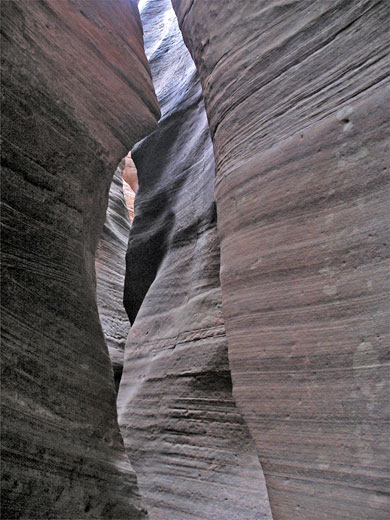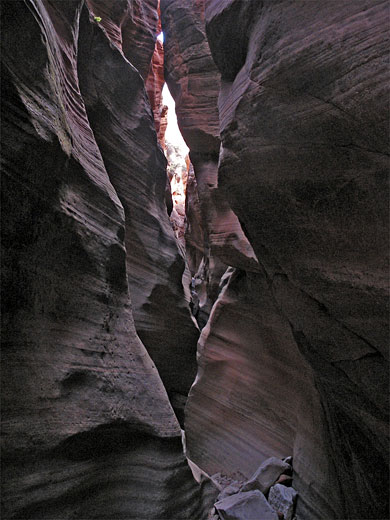Keyhole Canyon
Minor drainage on the north side of Clear Creek, containing three narrows sections; shallow upper passages, a short enclosed middle with several moderate obstacles, then a dark slot through reddish black sandstone, where ropes are needed in 3 places. Most can be seen via hiking
Length: 1.2 miles, round trip, to see the hikeable parts of the canyon
Difficulty: Easy to moderate; various chokestones to climb over
Management: NPS - within Zion National Park
Rocks: Navajo sandstone
Season: Spring, summer, fall
Trailhead: Pullout on the south side of UT 9
Rating (1-5): ★★★★★
Difficulty: Easy to moderate; various chokestones to climb over
Management: NPS - within Zion National Park
Rocks: Navajo sandstone
Season: Spring, summer, fall
Trailhead: Pullout on the south side of UT 9
Rating (1-5): ★★★★★
Many of Zion's canyons are deep, long and have a permanent stream flowing through, but the national park also contains plenty of short, narrow slots, and the easiest reached is undoubtedly Keyhole Canyon, the lower end of which is just 300 feet from UT 9, on the east side of the park half way between the entrance station and the Zion-Mt Carmel Tunnel. Keyhole has three sections of narrows; a shallow, open, upper section, a short enclosed middle with several moderate obstacles then a deeper, 500 foot long lower slot where ropes are required in at least three places to overcome sheer drops of up to 20 feet.
The compact nature of the narrows and the proximity to the highway mean that Keyhole is considered to be the best place in the national park to learn or practise rappelling techniques, though despite this the majority of the canyon can still be seen by regular hikers. The rocks in the narrows are eroded into the familiar wavy formations and contain numerous thin strata so the canyon is quite pretty, just not as photogenic as some since the majority of the passageways are rather gloomy.
The Navajo sandstone rock in this location is naturally dull red in color and most surfaces have been weathered to shades of grey and black; together with the predominantly east-west orientation, the overhanging rocks in the narrows and the higher cliffs above on the south side, much of the canyon is only rarely illuminated by the sun so the deepest parts are dark and cold. Pools and patches of mud persist in some sections all year.

Parking for the hike is 2 miles from the eastern national park entrance at two small pull-outs along UT 9 - one immediately south of the end of the canyon and another round a corner to the east (see map below).
The lower end of the narrows can be seen by hiking up from the road, past a tunnel that takes flood waters under the highway, and reaching the slot after a 5 minute walk up the sandy wash. Red and white cliffs rise steeply overhead, and the canyon is soon dark and enclosed. A chokestone above a pool provides the first major obstacle; webbing is attached to a rappel point though the rock is easy enough to climb. Beyond are darker passages containing cold, muddy pools, enclosed by stratified rock walls that in some places are angled away from vertical.
A taller dryfall puts an end to further progress upstream but the start of these lower narrows can be reached by backtracking to the start of the slot, climbing the rocks on the east side, crossing a ridge and descending to a temporarily open section of the wash, where a tributary joins from the north. A 20 foot drop off marking the start of the slot is just downstream, while in the other direction, the canyon emerges from the less deep middle narrows. However, as these are easiest to follow downwards rather than upstream, the best option, after visiting the end of the lower slot, is to return to the highway, walk 0.2 miles east and take a cross-country route along a faint trail up the side of a slickrock ravine - aiming just right of a small dome at the top - then head down the steep, sandy slope on the far side. This route joins the wash between the shallow upper narrows and the deeper middle section, which is the best part for those not rappelling.
Turning left (downstream), the walls draw together forming a good slot, enclosed by dark red rocks and containing plenty of pools and chokestones - less deep than the lower narrows though better lit. The one main obstruction is a slanting drop of about 15 feet into a pool, passable by sliding down carefully. Below are other dryfalls of 4 to 6 feet formed by boulders above pools, before the passage opens out to the short sandy stretch preceding the technical section. Upstream of the cross-country entrance point, shallow but still pretty narrows extend a quarter mile north, blocked by just a few troublesome chokestones. The canyon walls gradually decrease in height allowing various other entry/exit routes, until the slot ends and the wash continues at ground level, winding northwards beneath smooth white sandstone cliffs.
The compact nature of the narrows and the proximity to the highway mean that Keyhole is considered to be the best place in the national park to learn or practise rappelling techniques, though despite this the majority of the canyon can still be seen by regular hikers. The rocks in the narrows are eroded into the familiar wavy formations and contain numerous thin strata so the canyon is quite pretty, just not as photogenic as some since the majority of the passageways are rather gloomy.
The Navajo sandstone rock in this location is naturally dull red in color and most surfaces have been weathered to shades of grey and black; together with the predominantly east-west orientation, the overhanging rocks in the narrows and the higher cliffs above on the south side, much of the canyon is only rarely illuminated by the sun so the deepest parts are dark and cold. Pools and patches of mud persist in some sections all year.
Topographic Map of Keyhole Canyon

Location
Parking for the hike is 2 miles from the eastern national park entrance at two small pull-outs along UT 9 - one immediately south of the end of the canyon and another round a corner to the east (see map below).
Keyhole Canyon Route Description
The lower end of the narrows can be seen by hiking up from the road, past a tunnel that takes flood waters under the highway, and reaching the slot after a 5 minute walk up the sandy wash. Red and white cliffs rise steeply overhead, and the canyon is soon dark and enclosed. A chokestone above a pool provides the first major obstacle; webbing is attached to a rappel point though the rock is easy enough to climb. Beyond are darker passages containing cold, muddy pools, enclosed by stratified rock walls that in some places are angled away from vertical.
Bypass Route
A taller dryfall puts an end to further progress upstream but the start of these lower narrows can be reached by backtracking to the start of the slot, climbing the rocks on the east side, crossing a ridge and descending to a temporarily open section of the wash, where a tributary joins from the north. A 20 foot drop off marking the start of the slot is just downstream, while in the other direction, the canyon emerges from the less deep middle narrows. However, as these are easiest to follow downwards rather than upstream, the best option, after visiting the end of the lower slot, is to return to the highway, walk 0.2 miles east and take a cross-country route along a faint trail up the side of a slickrock ravine - aiming just right of a small dome at the top - then head down the steep, sandy slope on the far side. This route joins the wash between the shallow upper narrows and the deeper middle section, which is the best part for those not rappelling.
The Upper Narrows
Turning left (downstream), the walls draw together forming a good slot, enclosed by dark red rocks and containing plenty of pools and chokestones - less deep than the lower narrows though better lit. The one main obstruction is a slanting drop of about 15 feet into a pool, passable by sliding down carefully. Below are other dryfalls of 4 to 6 feet formed by boulders above pools, before the passage opens out to the short sandy stretch preceding the technical section. Upstream of the cross-country entrance point, shallow but still pretty narrows extend a quarter mile north, blocked by just a few troublesome chokestones. The canyon walls gradually decrease in height allowing various other entry/exit routes, until the slot ends and the wash continues at ground level, winding northwards beneath smooth white sandstone cliffs.
Keyhole Canyon - Similar Hikes
All Contents © Copyright The American Southwest | Comments and Questions | Contribute | Affiliate Marketing Disclosure | Site Map
















